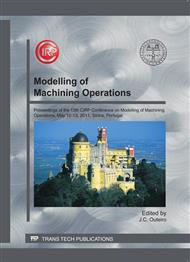p.296
p.304
p.314
p.325
p.332
p.340
p.350
p.359
p.371
Strain Rate Effect on the Mechanical Behavior of Austenitic Stainless Steel during Machining
Abstract:
Machining is characterized by a large amount of localized plastic strain on material due to chip formation; hence, there is a commitment among the strain process, strain hardening, and heat softening, generating shear bands. Understanding these shear zones is important because it contains information that can be applied to the improvement of machining techniques related to process optimization, and to materials and tools innovation. In this sense, the aim is to analyze the strain and the strain hardening with the strain rate variation as from the chip formed during the austenitic stainless steel AISI 304 turning. The results showed that the cut type, orthogonal or semi-orthogonal machining, affects the way the material strains, and that the strain rate has no significant effect on the strain and strain hardening of the austenitic stainless steel AISI 304 for the range investigated.
Info:
Periodical:
Pages:
332-339
Citation:
Online since:
April 2011
Keywords:
Price:
Сopyright:
© 2011 Trans Tech Publications Ltd. All Rights Reserved
Share:
Citation:


